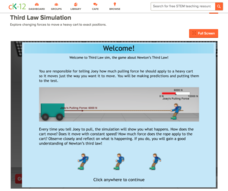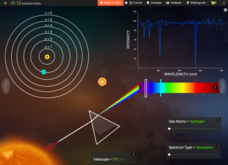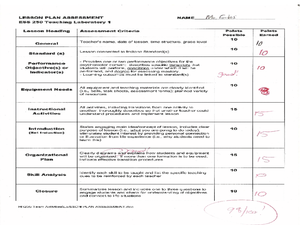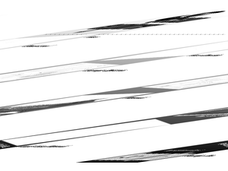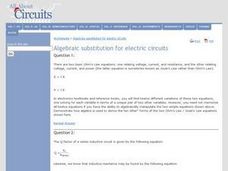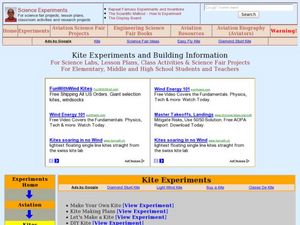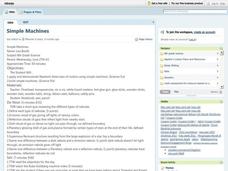Curated OER
Sound and Frequency
Pupils pose their hypothesis, they ready their instruments, then record their observations. This is the science of sound lesson. They move through 5 stations, each focused on a different element of aspect of sound. Check this lesson out,...
CK-12 Foundation
Third Law Simulation
Keep calm and use the force! Joey pulls a cart and scholars adjust the force required to control the movement. Through simulating different scenarios, participants learn about Newton's Third Law. It includes analysis questions throughout...
CK-12 Foundation
Power and Efficiency Simulation
How much energy in Jewels does it take to tow a car up a slope? Scholars explore different values of both kinetic and potential energy to answer that question. Through multiple levels, the difficulty increases — as does your young...
Science Matters
Energy and Winds
In the study of wind energy, scholars build a small windmill and observe how it transfers wind into mechanical energy. Learners will make connections to the previous lesson with concepts such as the creation of wind through convection.
Curated OER
Density
This sequence of slides is a fabulous introduction to the concept of density as it relates to mass, volume, physical impact, and interpretation. Various examples are given and your class will find the charts and procedures helpful in...
CK-12 Foundation
Atomic Colors
Stars are too hot to visit, so how do we know what different stars are made of? An enlightening simulation uses a spectrum graph to show the various electron emission and absorption reactions. Scholars experiment with both helium and...
Science Matters
Renewable and Nonrenewable Resources
Did you know there are at least 12 different energy sources? Scholars apply their knowledge about the different types of energy as they sort energy sources by renewable and nonrenewable. Then they pick one from each section to explain in...
Curated OER
Energy
Wow! Colorful and simple, these 160 slides introduce the various forms of energy, along with a relevant image. Some of the images are animations, which help beginning physical scientists to visualize the flow of electrons or energy! This...
Science Matters
Electricity and Magnetism Formative Assessment #2
Leave it to science to get scholars out of a jam. Young scientists use what they've learned about electricity and magnetism in the previous eight lessons in the series to build tools that will allow them to find their way out of the...
Curated OER
Balanced Forces
Examples and practice questions will help real-life understanding of the Principle of Moments concept. These great slides define the types of levers and pivots, and then give examples of the typical seesaw situations that help the...
Curated OER
Introduction And Brief History of Materials Science
Learners develop an understanding of the concept of matter. They l participate actively in the bubble raft experiment as described on the Center for Thermal Spray Research's website. They demonstrate dislocations and grain...
Curated OER
Volleyball Lesson
Students explore their physical abilities by participating in a sport. In this volleyball lesson, students discover the different techniques and skills needed to play volleyball by moving from different stations with small groups....
Curated OER
Parachutes: What a Drag
Sixth graders make 2 different kinds of parachutes and record and graph the time for each one for the different drag forces. In this parachute lesson plan, 6th graders compare the results to the rest of the class of each parachute and...
Curated OER
Big Enough?
Students explore the concept of density and buoyancy. In this physics lesson, students discover the different factors that affect an object's density and buoyancy in water. Students conduct several investigations to further understand...
Curated OER
Wow Waves (Waves on the Fly)
Students formulate hypotheses on wave behavior and test them. In this physics lesson, students compare and contrast transverse and compression waves. They determine the wavelength of transverse waves.
Curated OER
The Brain: Control Central
Students investigate the brain as the organ that regulates all of their physical, emotional, and cognitive responses. Some of the components of mental illness are examined inn this lesson.
Curated OER
Algebraic Substitution for Electric Circuits
For this physics worksheet, students use Ohm's law to solve for voltage, current and resistance. They answer 13 problem solving questions using Ohm's law.
Curated OER
Heart Rate
Learners move through a variety of locomotor skills at different paces to see how they affect their heart rate. In this health, human body, and physical activity lesson plan, students measure their heart rate and discuss health. A...
Curated OER
Kite Experiments and Building Information
Young scholars build their own kite following certain procedures. In this physics lesson, students explain the aerodynamics concepts involved in flying kites. They trace the development of aviation.
Curated OER
Thermo and Fluid Dynamics of a Homemade "Lava Lamp"
Learners construct their own lava lamp using simple substances. In this physics lesson, students explain how difference in density causes convection. They solve for forces and buoyancy using mathematical equations.
Curated OER
Las Maquinas y Nosotros: Machines and Us
Second graders explain the relationship between energy and work. In this technology lesson plan, 2nd graders describe the different uses of machines in their everyday lives. They record observations and data in their science journal.
Curated OER
Objects Race 500
Students explore the concept of "shape affects speed" through a series of experiments. In this physics lesson, students participate in an experiment in which various objects are released on an inclined plane. Speed and distance are...
Curated OER
Graphing Your Motion with Vernier LabQuests
Seventh graders create motion graphs using a motion sensor. In this physics lesson, 7th graders match the graph shown by moving their body. They relate the slope to the way they moved.
Curated OER
Simple Machines
Students engage in a lesson that is concerned with the concept of a simple machine and uses the law of motion to justify why they operate. Students explore the laws by constructing some simple machines to illustrate the concepts.



